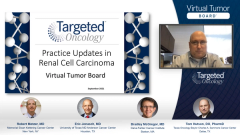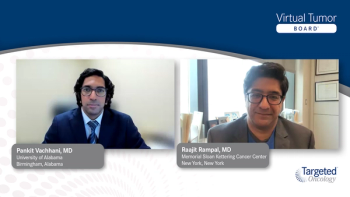
Case 2: Favorable-Risk First-Line Treatments in mRCC
The expert panel and Dr Eric Jonasch discuss data on first-line immunochemotherapy combinations for favorable-risk mRCC.
Episodes in this series

Robert Motzer, MD: Eric, maybe you can provide us an overview or a summary of your approach to discussing treatment options with a favorable-risk patient and a high-level review of the data that you use to formulate that discussion.
Eric Jonasch, MD: My colleagues have summarized this extremely well with regard to the dilemmas we’re facing. It comes down to whether the patients are more interested in quality of life or what I would call intermediary end points of benefit, like progression-free survival [PFS] and complete response [CR], knowing that this is not necessarily associated with an overall survival [OS] benefit. The psychology and the stress associated with progression should not be minimized. It’s an important factor to discuss with patients.
We have 3 trials. We have the KEYNOTE-426 study, the CheckMate 9ER study, and the CLEAR study…. Concerning the percentage of patients who had favorable-risk disease, we could see it ranged a little: for KEYNOTE-426 it was 32%; CheckMate 9ER, 23%; CLEAR, 27%. You can see here that the longest median follow-up was with KEYNOTE-426 but at least 2 years in all these studies, and also the median overall survival data for the entire population.
Moving down to the median overall survival hazard ratios in the favorable-risk group—that’s the first blue row here—we see that the hazard ratios are overlapping 1 and aren’t statistically significant. That’s the striking and important thing to realize, that we aren’t seeing that overall survival advantage. This is true also for ipilimumab-nivolumab. We then see, however, that the median PFS in this group is 15.7 vs 11.1 months in KEYNOTE-426, is 17 vs 8.3 months in CheckMate 9ER, and 23.9 vs 9.2 months [in CLEAR] in the aggregate group.
Going down to the median progression-free survival in the favorable-risk group—that’s the next blue row here—we have 20.7 vs 17.8 months [for KEYNOTE-426], 24.7 vs 12.8 months [for CheckMate 9ER], and 28.1 vs 12.9 months [for CLEAR] with the hazard ratios you see here. Some of them—for example, the axitinib-pembrolizumab—are overlapping 1 but others aren’t. You can see that they’re clearly favoring this. The objective response rate was 60 vs 39 months [for KEYNOTE-426], 55 vs 28 months [for CheckMate 9ER], and 71 vs 36 months [for CLEAR] in the overall population. When we look in the favorable-risk group, it was 69% vs 40% [for KEYNOTE-426], 66 vs 40% for CheckMate 9ER, and 68 vs 51% for CLEAR. For the CR rates, we’re seeing here 12% for KEYNOTE-426 in the favorable-risk group, 9% in CheckMate 9ER, and 21% in CLEAR. Some numbers here are pretty darn good compared with the sunitinib arm, but OS isn’t significantly different.
In this patient, axitinib-pembrolizumab was initiated. They demonstrated stable disease in follow-up. They have moderate diarrhea, which was well controlled with antidiarrheal medication, and there’s some mild fatigue. Fourteen months after initiation of systemic therapy, the patient reported worsening back pain, mild nausea, and weight loss. Imaging confirmed disease progression. There was growth of mediastinal lymph node, there was new mediastinal and hilar lymph node involvement, and new retroperitoneal lymph nodes.
Robert Motzer, MD: This person looks like they’re obviously progressing on a first-line therapy. One of the questions is, for the clinical trials we apply RECIST [Response Evaluation Criteria in Solid Tumors] criteria, which are quite strict. But in terms of clinical practice, outside a trial, what goes into your decision that this patient has progressed? Do you apply strict RECIST criteria? How is this done? I’ll ask Tom Hutson to comment on that.
Tom Hutson, DO, PharmD: Bob, thank you. I don’t apply strict RECIST criteria in real-life situations. It’s easy to determine who’s had significant progression. I use the words significant progression, and I have to define that to the patient. It’s going to be progression in new sites, new areas, new organs. That’s significant progression, and it’s a different situation from slow growth and existing disease.
If it’s slow growth and existing disease, how much growth has there been over time—the adverse effects and quality of life and things factor in on the person’s wanting to stay on. For instance, if someone has found that sweet spot that Eric had mentioned, and they’re doing great and not limited, and they’ve had some slowly progressive disease but no spread, then that’s a situation I would milk more and let the patient stay on therapy longer. And they would generally want that vs someone who’s had a horrible adverse-effect profile, that same degree of growth may prompt me to change therapy. You need to individualize what you define as progression with what’s important. What matters to the patient is what it comes down to. That’s what Eric was alluding to before: what matters to the patient.
Robert Motzer, MD: One thing we’ve seen in the last couple of years is a sweeping change in our first-line therapy for RCC [renal cell carcinoma] with integration of I/O [immuno-oncology] therapy into treatment and a better outcome. It’s left us with questions: What do we do with the patient who’s progressed on this therapy? There’s limited evidence and a major change in paradigm. Eric, what do you think in terms of what we know about the optimal therapy for second-line treatment? Do we have guidance from the NCCN [National Comprehensive Cancer Network]? Could you speak to those guidelines?
Eric Jonasch, MD: Interesting, Bob. We definitely have recommendations for second-line treatment options in individuals with metastatic renal cell carcinoma. But we all know that we don’t have level 1 evidence in individuals who’ve progressed on any of these fantastic new regimens that have all come up since 2018. We have agents like single-agent cabozantinib, lenvatinib, and everolimus, single-agent nivolumab that are regimens of choice in the second-line setting. But the big question is what should we give for an individual, for example, who’s progressed on pembrolizumab and axitinib? The METEOR study, when it was run, wasn’t able to answer that question because these individuals had been on TKI [tyrosine kinase inhibitor] frontline therapy.
Transcript edited for clarity.







































